Elizabeth Harrin's Blog, page 34
October 10, 2022
7 Factors of Good Governance
Projects ideally sit within a governance framework that is bigger than the project team. It’s actually easier to work in an environment where there is governance in place because it gives you boundaries. And, like toddlers, people respond well when they know how far they can go.
But what does governance on projects actually look like? Here are 7 factors that make up good governance. How many of these do you have on your project?
1. You have a sponsorA good governance model requires every project to have a project sponsor and while you read about sponsorship all the time on blogs like these in reality I still come across people who don’t know who their sponsor is.
A sponsor should be appointed during the very early days of the project. He or she is responsible for the business case. When the project is approved they are the people responsible for finding the resources and setting the vision for the team.
They also are the main risk-taker and decision-maker on the project so it’s important to have them around.
2. You have a planEvery project requires a plan and that’s more than a Gantt chart. The project management plan is the responsibility of the project manager, although everyone in the team will end up having input to it.
It’s made up of lots of sub-plans that cover how you are going to manage quality, risk, change, resources, and so on, so it’s the foundations for the governance and structure for the work.
If you have worked on projects before then it’s highly likely that you can copy and paste from previous documents so don’t get too hung up on the idea that a fully-fledged plan is going to be days worth of work for your tiny project.
We recommend: Project Management Plan Template
3. You have clear reportingClearly defined reporting is an important governance element because it’s reports that tell the steering group what is going on. As the key decision-making group, they need enough information to be able to make the right decisions without being bogged down in the detail.
Doing this part of governance is most likely in your project manager job description: it’s such an important part of the role.
You’ll probably end up with a number of different types of reports going to different audiences: project reports, budget reports, briefings to senior managers, and others that you do on an ad hoc basis.
We recommend: Project Status Report Template
A common structure and templates for your reports make the governance element easier because it aids comparison between projects. Again, reuse documents that you have already produced to streamline the effort and ask around to see if your PMO or colleagues have templates that you can use.
4. Your stakeholders are engagedLet’s recap: stakeholders are anyone affected by, participating in, or impacted by the project.
Engaged stakeholders – how does that fit into governance? Well, without having stakeholders who are participative you might miss issues. Engaged stakeholders are willing to raise problems and they do the actions that are assigned to them, whether they are the Chief Exec or a frontline staff member.
The more engaged the stakeholder community, the easier it is to do the work on the project – trust me, that’s experience speaking on that one! The stakeholders can be your eyes and ears: they listen out for what’s troubling end users, they report back on potential problems before they happen, they bring their subject matter expertise to thorny issues and they support you and the project team.
Knowing you’ve got a great group out there identifying risks and making sure that your end result is fit for purpose is a great way to boost the informal aspects of governance on the project.
Engaging Stakeholders on Projects: How to harness people power £25.00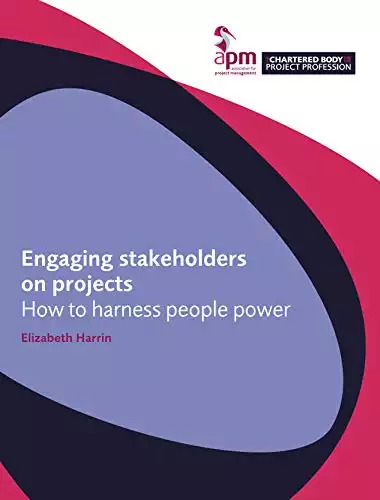 Buy Now We earn a commission if you click this link and make a purchase, at no additional cost to you #ad 10/10/2022 08:35 am GMT 5. You manage lessons learned
Buy Now We earn a commission if you click this link and make a purchase, at no additional cost to you #ad 10/10/2022 08:35 am GMT 5. You manage lessons learnedI mean really manage them – not just capture them in a post-implementation document and then file them away where no other project managers can find them.
Lessons learned feed into governance because it shows you have a culture of continuous improvement. How frustrating is it to make a mistake and then have someone say: “Oh yes, that happened to me last time!”
Why didn’t they just warn you first and save the company a pile of money and you from some headaches?
Embedded lessons learned can be a large change to the culture if you don’t do it already but sharing lessons between projects is a good way to improve the culture of delivery and project governance overall.
If your company doesn’t do lessons learned in a structured, corporate way, look at what you can do to build it into your project team meetings so that at least within your team you are sharing your successes and ‘could do betters’.
We recommend: Lessons Learned Meeting Minutes Template
6. You have clear roles and responsibilitiesThis takes us back to the toddler analogy. Knowing what you are responsible for and what your colleagues are responsible for doesn’t mean that you end up all being jobsworthy.
You can still pitch in and help get the work done when necessary, but day-to-day you aren’t treading on each other’s toes because you don’t know where the boundaries are.
At best, poorly defined roles and responsibilities on the project team results in miscommunication and duplicating effort because you don’t know who to talk to and you might end up doing a task that someone else believes is their job.
At worst, unclear responsibilities mean that no one really gets on with anything, and the project stalls as no one knows who is supposed to be doing what.
This is very easy to fix and to put in place if you don’t have it set up already. Set up a Terms of Reference for the project or include a section on roles and responsibilities for the team members in the Project Charter or Initiation Document. You could also write it into your resource management plan if you felt it fits better there.
It doesn’t really matter where it goes, or whether it’s in writing at all. The point is that people know their roles and who to ask for other things.
We recommend: Stakeholder Roles and Responsibilities Template
7. Projects are stopped when they need to be stoppedProjects that serve no purpose are soul-destroying places. You know that there isn’t any point in delivering what you are going to deliver, but because no one has the courage to stop the project you all lumber on towards the finish line.
What a waste of time and resources.
Projects should be stopped when they can no longer be justified. That’s the point of gate reviews (or stage reviews, or whatever you call them in your company).
You and your sponsor review the project’s progress and what it can now realistically achieve against the stated benefits in the business case and make the decision: is it worth carrying on?
If it isn’t, the project sponsor will make the call to close the work down.
Read next: A Guide to Project Closure
Your next stepsThese 7 factors will help you build a good governance structure on your projects. If you don’t identify with them, ask yourself if there is anything you can do to start bringing these practices into your project.
Here are some actions to get started:
Book project board meetings (or steering group meetings if you use that term)Book one-to-one conversations with your project sponsorTalk to the PMO about a standard project reporting templateBook a lessons learned meetingRevisit your roles and responsibilities, or create a document that sets them out if you don’t already have one for the team.Further readingI’ve rounded up a list of my recommended project governance books.
An older version of this article first appeared on the 2080 blog in 2016.
Pin for later reading
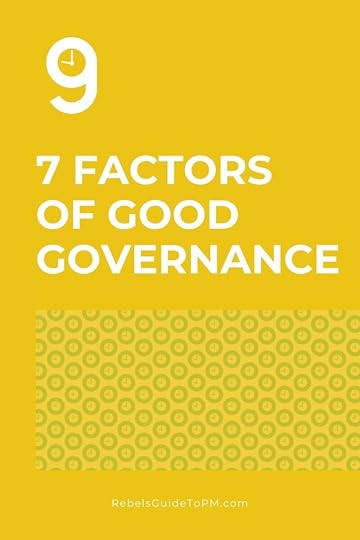
This article first appeared at Rebel's Guide to Project Management
October 5, 2022
How to Get Projects From Strategy
This is a question I’m hearing quite a lot at the moment: How do I turn my company’s strategy into actual projects?
It’s good to have a strategy, of course. But a strategy that stays in a fancy PowerPoint presentation isn’t helpful to anyone. That’s not a strategy, it’s a document.
OK, you need the document first, as a communication tool to explain the strategy to everyone, but you know what I mean. A pretty document doesn’t change the way you run your business or help you achieve your goals. People do that.
If you are in a PMO, you might have this challenge. So how do you get to a place where people can deliver on the strategy that has been set? You go from strategy document to project portfolio like this:
Identify strategic themesDefine leading indicatorsChoose the measuresSet the targetsDefine the projectsJoin the projects up into a portfolioIt starts by breaking down the strategy.
1. Identify strategic themesMorgan, Levitt, and Malek discuss this in their book, Executing Your Strategy: How to Break It Down and Get it Done. They talk about translating strategy into specific objectives. This is how it works.
First, hold a strategy planning meeting to identify the strategic themes from the strategy. These are the big headlines, and the titles on the PowerPoint deck. In the book, they use an example of an airline. The strategic theme is operational efficiency (a common strategic pillar that I’ve seen all over the place – who doesn’t want to be efficient in their operations?).
You’ll have a number of strategic themes from your own corporate strategy. I think it’s helpful to start with one and break that down first. Then you can do the same exercise with the others.
Executing Your Strategy: How to Break It Down and Get It DoneIn Executing Your Strategy, Mark Morgan, Raymond Levitt, and William Malek present six imperatives that enable you to do the right strategic projects—and do those projects right.
 Buy at Wordery Buy at AbeBooks We earn a commission if you click this link and make a purchase, at no additional cost to you #ad 2. Define the leading indicators
Buy at Wordery Buy at AbeBooks We earn a commission if you click this link and make a purchase, at no additional cost to you #ad 2. Define the leading indicatorsA leading indicator is a measure that predicts what change will happen. It helps you forecast future performance and define what actions are required for course correction if you aren’t going to be on track or delivering the results you were expecting.
That makes our next step working out the indicators that underpin that strategic objective.
There’s a lot that goes into operational effectiveness, so there may be several indicators that come out of the discussion. In the book, they give one example, fast turnaround for planes on the ground. You can see how this is directly linked to being operationally effective. The faster you can turn planes around, the more flights you can have in the air, the happier passengers are not to be kept waiting, and so on.
However, there’s a trick to choosing the right indicator and the clue is in the title. ‘Leading’ indicators are ones that can be tracked in real-time.
Turnaround time is a valid and real-time measure of effectiveness.
A lagging indicator doesn’t reflect real-time performance. While you will want some of those as well, if you chose profit margin per flight, or return on investment, you can’t track them in real-time.
There’s a huge benefit to having indicators that are as near to real-time as you can possibly make them.
They give you a much earlier warning that a project is not having the desired effect. It makes you much more nimble in being able to step in to make changes because your data is not 6 months out of date by the time you get it.
3. Choose the measuresNow you know what the right leading indicators are, you can establish the measures. For flight turnaround times, the measurement is dictated by minutes on the ground and the percentage of flights that have an on-time departure per day.
These measures take the strategy to the next level. You’ve already stated the objective and established what is important to track, now you’re working out exactly what elements need to be measured.
4. Set the targetsWe’re getting closer to something that can be useful in a project delivery environment. You have defined measures, now we need something to aim for.
This can either be stated in the level that must be achieved e.g. 95% of flights having an on-time departure per day, or an improvement that you desire e.g. to reduce ground time by 10% on 2017 times. It doesn’t matter exactly how you write your targets down as long as they are clear, measurable, and meaningful.
This is the kind of information that feeds into a project business case and gives you a mandate to start a project.
5. Define the projectsNow you have business targets that relate directly back to a strategy theme, you can see how a project devolves from that. Carrying on with the airline example, the project here is to improve cycle time for planes, and you could further specify that to a particular airport or route if necessary.
A cycle time optimisation project with a target of reducing ground time by 10% is something I can set up and manage. It’s directly linked back to the operating efficiency strategy theme and yet it is tangible enough for a project delivery team to work out a plan of how to get there.
6. Join the projects up into a portfolioOnce you have done this exercise for all the strategic themes, you’ll potentially have a lot of possible projects. I think there is value in joining it all up again. Managing multiple projects is a skill, and portfolio leaders need to be able to see the big picture.
Take a big picture view – the hot air balloon view – of how the strategy breaks down and take the time to review and prioritise the projects that you have identified. Some might not be that important, given the wider view. Others may jump to the top of the pile as the critical activities to kick off in the next quarter.
Strategy doesn’t have to be achieved all in one go. You can phase out your projects so that the things that make the most sense right now are given priority to begin straight away.
However, the big-picture view lets you see where you are investing your time. You may want to spread out your projects so that each strategic theme has at least one active initiative. Otherwise, you’ve got a strategic pillar that is apparently important but no one is working on it (back to strategy being more than just a document).
Your project management office can assist with this and make sure that the spread of projects covers all the essential areas.
Yes, it takes time to do this for all your strategic objectives. Yes, it’s difficult to make the jump from objective to measure in some cases, especially with projects that are more about knowledge work than process improvement.
But this journey from strategy to executable project definition is something that we see lacking in many businesses.
They may have a mature approach to managing projects and a good culture that sets project teams up for success, but they are doing the wrong projects for moving forward in a way that meets their strategy.
Read next: How to decide what projects to do
An older version of this article first appeared on the 2080 blog in 2017.
Pin for later reading
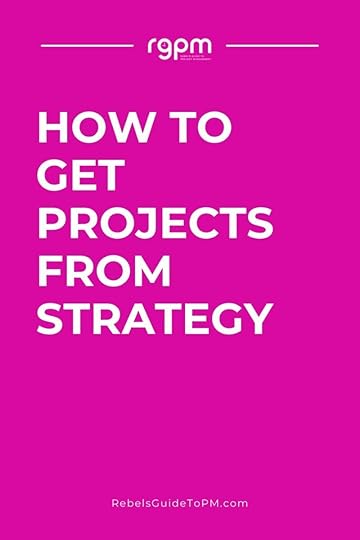
This article first appeared at Rebel's Guide to Project Management
October 2, 2022
Project Management in the Hybrid Workplace (Book Review)
Project Management in the Hybrid Workplace is the latest book from Phil Simon – a guy I think is smart, with a dry sense of humor, and who obviously loves researching all the nerdy things that make a book great.
It’s about how, for decades, organizations have found it challenging to deliver projects. Even when we all worked together in co-located offices.
Today, that in-person world of work has gone. And it doesn’t look like it is coming back any time soon. Remote and hybrid workplaces, and project teams, are the way strategy is getting delivered now.
But working in a hybrid team is difficult. There are several obstacles that make managing complex projects more of a challenge. If I’m honest, even managing easy projects is made harder by virtue of not being in the same office as my colleagues.
When I was more regularly in the office, it was easy to get in touch with people. I’d arrive early to catch them before they got sucked into meetings, or walk with them between buildings even when I didn’t need to go to the other building. But working remotely means it is harder to find those water cooler moments for quick catch-ups.
[image error]Not that I particularly want to go back to commuting 5 days a week. Just saying.
Phil draws from a wide range of critical research to bring together a multi-disciplinary look at why hybrid is hard and what we can do to make it easier.
There’s a lot in the book, but I felt it was a little light on project management content for me. Chapters are packed with evidence, anecdotes, and explanations of why you should care about new ways of working and the dangers of not paying attention to workplace shifts. These are all useful and interesting in their own way.
The last third of the book is the ‘how to’ section and I wish it had been given a larger proportion of space because I do like practical takeaways. There is advice for working with suppliers and in multi-organizational teams, which is so relevant to the complex procurement environments we work in today. However, the reader is almost expected to draw their own lessons from the stories. The chapter summaries do help bring the learnings and action points to the surface.
There is no doubt that Phil Simon is a gifted storyteller, pitching at an educated audience. I really wanted to love this book as the topic is much needed but I didn’t get enough actual advice on what to do differently.
However, there are several big points, discussed in a chapter each that ensures the ideas have time to percolate. You’ll go away with a few big ideas of how to change the way you work as a hybrid team, and how communication channels between colleagues could be improved for the good of project delivery.
If you have read another of Phil’s books, Message Not Received, you’ll pick up on some of the same threads about communication approaches at work and how best to get your message out there and understood. I think I probably preferred that book, to be honest, although it is not aimed at a project management readership. It’s relevant for anyone who communicates with other people at work. So that’s all of us then.
Best for:
Multi-organizational teamsProject managers leading complex projects and hybrid teamsNewbies with 0-5 years experiencePeople needing evidence of why old methods are dangerous to project success to share with their boss.Not such a great read if:
You’re already practiced at hybridYou only work with internal teamsThe book is a multi-disciplinary take on what it means to manage work successfully in a world where people could—and frequently are—anywhere. If you’re feeling fried by the cognitive load of hybrid and remote work, this book will help you think and act differently. You’ll feel better for it.
Join me talking to Phil Simon about sushi, spaghetti, and side dish project management (amongst other things) on his show Conversations about Collaboration.
Project Management in the Hybrid Workplace (Book Review)
Read my review of Phil Simon's book Project Management in the Hybrid Workplace.
URL: https://www.philsimon.com/books/proje...
Author: Elizabeth Harrin
Editor's Rating:4
Pin for later reading
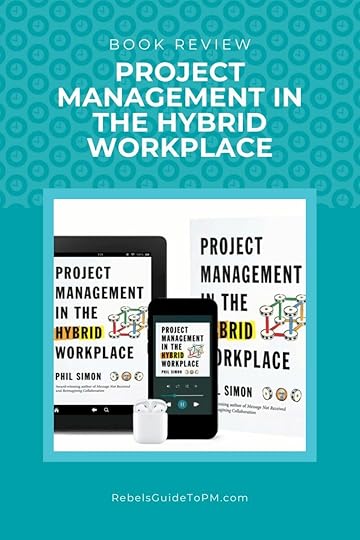
This article first appeared at Rebel's Guide to Project Management
October 1, 2022
Top 10 Books on Change Management (2023 edition)
Change management is so important for making sure that the change you deliver is embedded in the organization. In other words, if you want people to use what you create — or to shift their ways of working to the new standards and processes you implement — then you have to help them through the transition.
Here’s my list of top change management books for leaders.
See this list (and some extras) on Amazon.
Short on time? Buy Leading Change by John P. Kotter. It’s my top pick
How I chose these booksI looked for:
Writing style and whether they were engaging and easy to followContents — how much did the book provide in terms of things you could repeat yourself at work?Inspiration — how did I feel after reading the book? Was I inspired to put the ideas into practice?1. Leading Change by John P. KotterProfessor John P. Kotter is a leading authority in change management, and this is the book to start with. Leading Change (2012) is a comprehensive guide to his 8-step process for managing change.
Kotter’s way isn’t the only way to manage organizational change, but it’s a common model now and it’s helpful to understand the process so you can see what, if anything, you want to apply to your own projects.
Kotter’s 8-step change process is:
Create a sense of urgencyForm a guiding coalition as the change teamCreate a vision for the changeCommunicate the visionEmpower people to take action by removing barriersCreate the opportunity for quick, short-term winsBuild on the change incrementallyMake it stick for the long term.That’s a super high-level overview, and the book goes into it in much more detail.
2. Making Sense of Change Management by Esther Cameron and Mike GreenMaking Sense of Change Management: A Complete Guide to the Models, Tools, and Techniques of Organizational Change is now in its fifth edition.
It’s a bestseller, billed as the “definitive” guide to change management, and it’s comprehensive. You’ll learn the theories and change management models and see how you can use those in the workplace.
Aimed at people doing change management in a leadership role (aren’t we all?), it will help you understand how to adapt an organization in readiness for change.
I think this book is more for transformative, disruptive, organizational change instead of project-led ‘small’ change, but the theories, case studies, and techniques can definitely be applied to a project environment.
3. Our Iceberg is Melting by John P. KotterAnother book by Kotter, Our Iceberg is Melting: Changing and Succeeding Under Any Conditions, is an easy read about why the ‘burning platform’ is essential to help businesses move to new ways of doing things.
I loved this book when I read it: it’s a business fable (which is not a type of book I like to read) but it’s fun, and it definitely gets the message across. It’s about a group of penguins living on an iceberg and how they come to terms with what their next steps should be. You’ll read it and be nodding along: “Oh, that’s just like my colleague X.”
The point of the book is to highlight different archetypes: the types of colleagues you will most likely be working with (or who will be blocking the change) during the project. When you better understand what drives them, you can create a change plan that supports everyone’s needs and brings people together behind the vision.
Oh, a ‘burning platform’ is where the change is so extreme you have to jump from the burning platform into the sea in order to move forward (and survive) and there is no going back. We had one of these on my largest project to date and it was an awesome way of helping people understand why we were going ahead with the change.
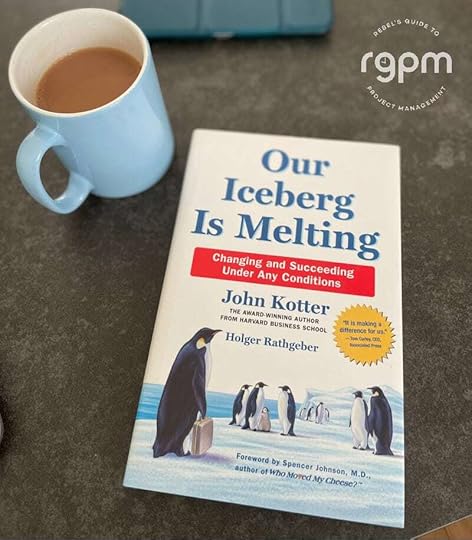 4. Communicating Change by Elizabeth Harrin
4. Communicating Change by Elizabeth HarrinDisclaimer: I wrote this one!
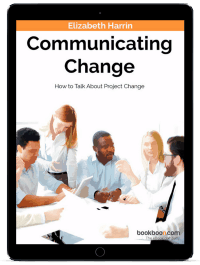
Communicating Change is all about how to talk to people about the changes your project is delivering. You’ll get lots of practical advice about what to say when, how to identify how people want to receive information as well as recommendations for doing the communication.
It focuses mainly on how to talk about change (in writing or in person) as in my view, this is the hardest part to do. If you can get people on side with what is happening — or at least deal with resistance to change when you cannot do that — then you’ll feel more confident about going ahead with the project and the change will land more effectively.
Communicating Change is published by Bookboon in ebook format, and you can get it here (or included in your Bookboon subscription if your company has an account). It’s one of the best things I’ve written, so if you can check it out, please do!
5. The Effective Change Manager’s Handbook edited by Richard Smith et alThe Effective Change Manager’s Handbook: Essential Guidance to the Change Management Body of Knowledge is an accessible and practical guide to what change managers actually do.
It has chapters written by well-respected practitioners, so while you will pick up the theory, the aim of the book is to make it possible for you to do change management in your organization, in big and small ways.
Aimed at people who don’t necessarily have the job title of change manager, if you deliver change as part of your role, you’ll find something useful in here to help. People who have change manager job titles may find other books a bit more useful, but often project managers are expected to do the change part of the work as well, without any formal training or guidance. This book is a good starting point.
The topics covered include sustaining change, change readiness, and there’s a section specifically on change in a project management setting. There’s also a substantial section on facilitation because talking to people is so much of what change management is all about. This is a good starting point to dive into the world of change management.
I’m always a bit wary of books written by multiple authors. While you get a great selection of voices and the book can include more expertise than a single-author book, sometimes they feel like the chapters don’t hang together well.
6. The Theory and Practice of Change Management by John HayesThis is another book that has had multiple editions, so be sure to get the latest version. The Theory and Practice of Change Management is a bestseller in the field but feels to me less accessible than some of the others on this list as it’s really essential reading for final year MBA and change management degree students.
Probably not the best one to start with, but it’s a well-respected guide to the field so it felt wrong to leave it out!
This one would suit you if you work in a large organization in the role of change manager, or feel that is a route you would like to go in the future. It’s essential reading if you are studying change or organizational leadership.
 7. Crucial Conversations by Kerry Patterson et al
7. Crucial Conversations by Kerry Patterson et alCrucial Conversations Tools for Talking When Stakes Are High is a frequently recommended book. This is less about the theory of change management, and more a guide to how to talk to people about change when it really matters.
It’s a reasonably priced book that will do well on your shelf for all kinds of situations, not just managing change at work. So many of the conversations we have to have as project managers need to be brave conversations. Whether you are providing feedback to someone who has failed to complete a task as expected to the required level, coaching an underperformer, or telling a customer that their deliverables aren’t ready, a lot of our conversations fall into the ‘difficult’ criteria.
This book will give you a rounded overview of how to face these conversations by preparing and reacting in the situation as necessary. You’ll feel more confident, and that’s really the goal, isn’t it?
8. Switch by Chip and Dan HeathChip and Dan Heath have written some great books, and Switch: How to change things when change is their well-read take on change management. I love their style and find their writing engaging.
This is a good guide to overcoming resistance to change, and its easy-to-read style means you’ll pick up nuggets of information without it feeling like your reading time is work time. You can pack this one in your commuting bag or grab the audio book version to listen to during your workout/run/baking time etc.
9. The Catalyst by Jonah Berger
The Catalyst (2020) is so good! There are so many wonderful examples in it, and I sat reading in the Waitrose cafe with avocado on toast not noticing the time passing. It’s a book about how to reduce resistance to change through removing the roadblocks.
Instead of pushing harder, first, seek to understand. Then you can dismantle the objections one at a time. Berger gives you a step-by-step guide to do exactly that. The case studies and examples are brilliant, and help illustrate his points with such clarity.
You’ll come away from this book with a totally different outlook on why people make the decisions they do and why they hold their points of view. Once that window in your brain has been opened, it will never close.
This one is a must-read.
10. Leading Transformation by Nathan Furr, Kyle Nel, and Thomas Zoega Ramsoy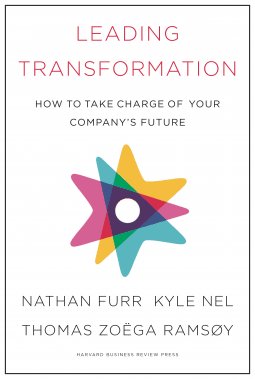
Leading Transformation: How to Take Charge of Your Company’s Future by Nathan Furr, Kyle Nel, and Thomas Zoega Ramsoy was an interesting read, but I’m not sure how repeatable the case study would be.
The book basically shares a fascinating business case study that resulted in organizational transformation. It draws heavily on neuroscience and change management and talks about using science fiction writers to design the vision for the future — sharing good practices relating to storytelling.
You’d need a brave organization to replicate the results, but there are tools in here in your own projects, especially around the use of stories to communicate the vision of the new world. Using visual tools to get your message across is not a new idea, but doing it with comics and in such an innovative way was a new take for me.
Your reading listAnd that’s your reading list for change management books! These books will give you a rounded view of change management, and plenty of practical tips for making organizational and project change run smoothly in your business — and stick.
Looking for some immediate tools on change management, check out the 8 levers of change post discussed by Shea and Solomon to get started.
If you are looking for some other suggestions for project management books to read, you can check these out:
Best PRINCE2® booksBooks by Elizabeth Harrin (that’s me!)Best books on project collaborationBest leadership books for project managers8 must read books on stakeholder managementWhich one will you read first?
Pin for later reading:

This article first appeared at Rebel's Guide to Project Management
September 29, 2022
5 Simple Reasons Why Processes Don’t Work
I bet you have plenty of project management processes, don’t you? One for risk, one for escalations, one for changes, issues, new project kick-off, closure, logging dependencies… the list goes on and on.
We couldn’t work without them. But they don’t always work.
The bottom line is this: having processes doesn’t guarantee that your project will be any better than if you didn’t have them.
That sounds a bit controversial; perhaps it is. But I’m a big believer in making sure everything is fit for purpose and processes are included in that. They have to work effectively and do what you need them to do. If they hinder you or don’t work at all then they are as good as having no processes – and sometimes the result is worse than having no processes!
The reasons why processes don’t work are actually pretty simple. Let’s look at 5 common reasons why processes fail to serve you when managing projects and what you can do about them.
1. Processes are too informal“Oh, sometimes we do it like this, but it doesn’t really matter.”
“There’s no strict way of doing it but…”
Informal processes cause you lots of problems. Do you follow them? Do you not? Who cares if you do it either way?
Then you find out that a colleague is working in a slightly different way to you and your stakeholders are confused about who is “right” or what format they need to provide updates in.
Equally, if you aren’t following a process at all you could end up with quality issues. An informal attitude might tumble over into a, “I didn’t think it mattered” attitude and suddenly no one remembers why you spent £100k on something as nothing was documented about who signed it off.
(This is why I organize a notebook for work and then transfer all the important decisions to a decision log.)
Fix by: Standardize, standardize, standardize. You can do this with templated processes and have different routes through the process depending on the type of project.
A large project might necessarily have different obligations than a smaller one. Everyone needs to know what is required from them so they can work to the right level of structure.
Read next: 5 golden rules for writing project documentation
2. Processes are too bureaucraticThere is a chance that processes lean too far in the other direction too. If your processes are heavily bureaucratic, with lots of winding paths and detailed steps to complete, then no one will be able to get anything through them.
The risk there is that people make up their own processes to work around the edges of the formal policy, skipping steps because they are focused on keeping the momentum going on their project. And in this situation, I would argue that’s probably the right thing to do.
There’s no point in supporting processes that add complexity for complexity’s sake.
This situation can happen when teams merge, or processes haven’t been reviewed over a long period of time. The steps that you used to do to support a particular business requirement aren’t needed anymore but no one has had the foresight to take them out. So you still do them, pointlessly and with bad grace.
Fix by: Work with the PMO to review the processes. Be explicit about issues where you see them not working and challenge the status quo.
Never be afraid to ask why you are required to do something and don’t take ‘that’s the way we do it round here’ as an answer!
3. Lack of understandingLet’s say that you have great, fit-for-purpose processes. If your team doesn’t know how to use them then they will simply be a burden around your neck.
The people doing the process need to know why they are doing it and what purpose it serves. If they don’t realise they have to use the room booking process for sorting out meeting rooms, they will continue to circumnavigate the process and go directly to the office manager: causing problems on both sides, I expect.
People need training on processes. That could be as easy as an email explaining what screen is changing in the software tools you use or a full-on classroom course. But you shouldn’t expect people to simply know what to do.
Fix by: Train your staff. Tell them why processes are required. Show them where to find the templates. Explain how to use the process and what to do if they need more help.
4. Process risk isn’t understoodThere is an element of risk in most business things, and processes are no different. If there is a risk that the process doesn’t work as expected you should be monitoring that (it’s most likely a task for your PMO) and ensuring that any subsequent issues with the process are captured and dealt with.
Process risk isn’t something we think about often because we like to believe all our processes are designed from best practices and tried-and-tested methodologies. But… then you introduce humans and complex work situations and suddenly those flow diagrams don’t look quite so robust any longer.
Process risk is things like:
People circumventing the processSteps not being carried out as expected or with the results you expectProcesses not fitting a particular type of project.Fix by: When you implement new processes, or even as the user of an existing process, be alert for points where it might fail you. You could even include these in your project risk register.
For example, there could be a risk that the budget sign-off process takes so long that even if your project sponsor is totally on top of it, the start date is delayed, with the subsequent impact on achieving the business case benefits that would bring.
5. Poor project managementFinally, poor project management can cause your processes to fail – and this time it’s going to be caused by the project manager, not by an inherent problem in the process itself.
You shouldn’t try to apply the issue identification process to an issue that has already been resolved. You shouldn’t try to use the escalation process formally to flag a problem that doesn’t require escalating. There’s little point in assigning tasks to resources when the work has already been completed.
It will look like those processes are letting you down but really it’s because an inexperienced project manager is trying to use them in a way they weren’t designed for.
Fix by: This is all about applying processes intelligently and using them as appropriate. That means using them at the right time for the right purpose. More experience, a mentor, and substantive training will help project managers have the confidence to apply the processes correctly in the right situations.
Processes are there to support you as you manage your project. They underpin how we get work done. But they are only as good as the steps in them and the people using them.
Apply some common sense to your project management processes. Big complex projects need big, complex structures to support them with all the governance, oversight, and process that implies. Smaller projects can follow the same path with a leaner approach.
Whatever your methodology, whatever your ways of working, applying them intelligently will avoid some of the pitfalls described here and keep your processes in good working order.
Action summaryStandardize your processes. It’s OK to have different paths through a process to suit different situations e.g. big and small projects.Review your current processes and look for areas where they aren’t working. Address these as a team to make improvements.Train the team in how to use processes effectively – and remember to cover the ‘why’ of the process as well.Document process risk on your risk log.Build confidence in using processes so you feel comfortable tailoring where necessary.An older version of this article first appeared on the 2080 blog in 2017.
Pin for later reading
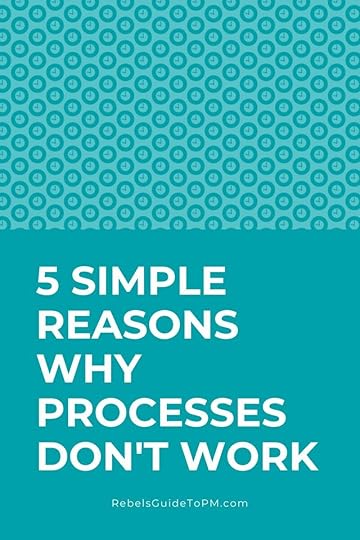
This article first appeared at Rebel's Guide to Project Management
September 28, 2022
Book Review: A Short Guide to Facilitating Risk Management
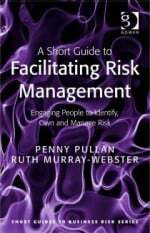
Risk meetings don’t have to be boring, although in my experience they often are. A Short Guide to Facilitating Risk Management is a book that specifically addresses how to get the best out of your risk management meetings.
This book, by Ruth Murray-Webster and Penny Pullan, provides practical guidance on facilitating risk workshops, and making project risk management happen outside of the workshop setting as well.
Dotted through with cartoons, the emphasis is on practical guidance for getting things done without suffocating those poor souls who have to attend risk reviews.
The book provides a clear introduction to tackling common project risks (including opportunities) in a fun, professional way, with the aim of gaining consensus. It’s very practical, with real-life examples to show how risk management can become ingrained in the day-to-day management of initiatives in your organization.
It’s also pragmatic: for example, they talk about a risk owner being someone “paid to care” about the impact the risk could have to the project objectives.
The benefits of risk managementThe authors start from the position that people are “naturally capable” risk managers. We’ve dodged sabre-tooth tigers, managed our way out of various plagues and we don’t run across motorways. If we weren’t capable of managing risk, we wouldn’t have come this far along the pathway of life.
They are also clear that risks include opportunities, and they use the Hillson and Murray-Webster definition of risk that says “Risks are uncertainties that matter.” Managing these uncertainties is what adds value to project delivery.
The authors provide three benefits of risk management:
There is less waste (of time and effort due to a reduction in problems that could have been foreseen, missed opportunities, re-work and hassle)There is more confidence (in plans, forecasts and relationships because there are fewer surprises)There are better decisions (because decision-making is based on the best possible information – not just about what is, but about what might be)If that doesn’t convince people that risk management is something to be taken seriously and done well, then I don’t know what will.
Great advice for risk meetingsEven if you have lots of facilitation experience you are likely to pick up some new techniques from this book. I particularly liked this one:
How can you check whether people are likely to do their actions?
Ask them about their intentionality – this is the strength of their intent to carry out each action. Penny uses a scale of 1 to 10 and asks people at the end of workshops to report how likely they are to get each action done. If they’re unsure that they will be able to do the actions, then she adjusts the action. Surely it is far better to have an imperfect action that’s completed, than a perfect one that isn’t?
There are also tips on who to include in risk meetings, how to manage the output and onward actions, and how to help people get over their fear of writing things on flip charts in public.
If you want to start engaging teams in risk management, then this book will show you how.
The book is only 30,000 words so it’s short (as the title says). That means you can read it in an afternoon, or just pick out the relevant parts as they become appropriate. There’s no excuse for poor risk management – and now you can learn to do it in a fun, engaging way. Even better!
Read more about this book online at the authors’ website: Facilitating Risk.
This article first appeared at Rebel's Guide to Project Management
Visual Project Management [Book Review]
Visual Project Management by Paul R. Williams, PMP. It’s quite a light book. Williams has put together all the different ways you can bring a visual element to your project communication and reporting. “Seeing is not only believing…seeing is understanding,” he writes.
He has split the graphical and visual tools available to you into three categories. They are all things you would consider to be project management artifacts. As a project manager, you’d create them during the project (or they would be created as part of the project).
I’m keen on communicating visually because it helps get the message across.
Here are the 3 categories of visual tools you can use on your projects, according to Williams.
Category #1. Visual Thinking Tools that Support Project ManagementMind MappingProcess MappingStoryboardingRoot Cause AnalysisCharting, Diagramming and GraphingDrawing and SketchingWireframesUse Cases and user storiesCategory #2. Visual Project Reporting ToolsEarned Value AnalysisDashboardsRoad MapsLean Concepts – KanbanAgile Concepts – ScrumInfographicsCategory #3. Visual Project Collaboration ToolsProject War RoomProject Science Fair (this is like an education event where a big company can host a fair with a stand for each project so employees can find out about the company’s initiatives)Project Display Wall (for when you don’t have space for a war room)Project Flight Status Board (i.e. table that shows which project is in which life cycle phase, colour coded to show status)Project Social Media (e.g. collaboration tools)3D Project Environments (real, e.g. 3D printing and virtual worlds, e.g. SecondLife – is that still around?)Project GamificationIf you want to get started, I’ve written about 5 ways to use visual communication on projects so you can get some easy ideas from there.
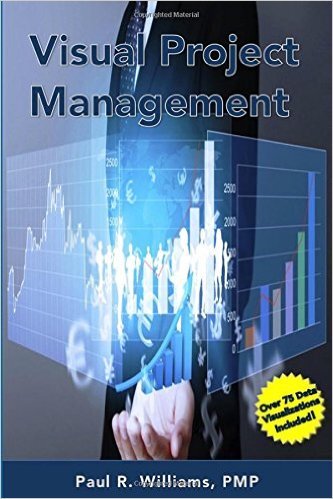 The rest of the review
The rest of the reviewI’m aware that this review is starting to read more like a Table of Contents than an actual review but I can’t think of much to say. The book lists the tools and then describes what they are. It’s a handbook-style read that helps you understand the different types of data visualizations in project management.
The concept of increasing the team’s understanding through pictures is a good one, especially when the data is complex.
There are lots of examples and screenshots to explain the tools. Each section ends with further resources/reading and references. There is a good explanation of Earned Value and useful advice on dashboards.
It’s good in that it collates all the ways of working with visuals specific to project management. I tried to think of anything the author might have left out and could only come up with visual recording for meetings, but you could argue that isn’t really a project management specific tool (but neither are dashboards, to be fair).
I’d say that this would help new and student project managers but I felt myself going, “OK, I could display errors during testing as a graph.” It’s not rocket science.
Having said that, I am not aware of any other book that sets out the tools for visualizing project concepts so clearly or comprehensively. If you are looking for a better way to present your complex data, you’ll find plenty of ideas in here.
This article first appeared at Rebel's Guide to Project Management
September 26, 2022
What is a Program in Project Management?
What is a program in project management terms? Here’s a definition.
A program is a set of related projects and activities, managed in a coordinated fashion and under a structure that allows for the delivery of outcomes and benefits.
In other words, it’s a bunch of projects being managed together.
What’s the point of a program in project management?The purpose of a program is to tie together related work.
If you work on a program, either as a project manager, or in a program office role (or as the program manager) you’ll know that the goal is that your work contributes to the organization’s strategic aims.
Program and project management makes it easier to manage resources and expenses because you can juggle priorities and manage multiple projects.
As long as you know where you want to get to overall, you can broadly make sure that you achieve that with the resources and budget that you have.
Project vs Program ManagementProject management delivers a single output. Program management delivers a business goal.
Programs can be transformative, although large projects can be too.
I have done both. As a program manager, I ran a collection of related projects with the goal of delivering improvements across the business on a large scale.
As a project manager, I ran complex projects with plenty of workstreams, but there was only one objective and one output.
For example:
Program: Digitize all our processes — this is a large scale goal that would involve many teams and many projects to achieve.
Project: Migrate the accounting software to a new tool — this might be a complex project that affects many staff, with serious implications for process re-engineering and training, but it’s just one initiative.
Program StructureFirst, let’s look at how programs fit into the project/program/portfolio way of looking at work.
Programs are collections of projects and BAU work that together will deliver an overall goal. Programs can be part of a portfolio or standalone. They can include a couple of projects or lots.
The picture below explains the program structure, with regards to how it fits into the rest of the project management jargon.
 Different Types of Program
Different Types of ProgramDid you know that there are three types of program? Yes, there are! They are:
Visionary programsEmerging programsMandatory programs.They are all valuable, but each has particular quirks which change how the team works and how they are managed. Let’s look at each of those in turn.
1. Visionary Programs“I have a vision…”
A vision-led program is where the senior leaders have a specific idea of what they want the organization to look like when the work is complete.
These tend to be transformative programs, delivering organizational or cultural change such as a restructure or fundamentally changing the operating principles of the business (going paperless, for example).
In this type of program you’ve got senior leadership support – and while it may sound obvious to say that, oftentimes you don’t have the sponsorship required in project management, so it’s a good thing that it is present here. It’s very much a top-down approach.
How these programs startManagement will have come up with an idea of the future state of the business in a strategy session, and the program is the practical way of getting there.
There will be a number of projects required to achieve those goals, so you could find yourself working on one of the projects delivering a component part, or in the program office itself managing the overall delivery.
There’s a strong commitment to the vision and what it will do for the company, and you’ll find that everyone gets behind it (or at least, most people) because they see that they have no choice: the company is changing anyway.
This makes the change relatively easy to handle but does mean the program team have to spend more time looking for people who are going to adversely affect the program but aren’t prepared to say so out loud for fear of appearing not to be committed to the upcoming changes.
While it helps in many ways to have such overt senior support, it does push resistance to change underground!
Read more about the role of change management on projects and programs.
2. Emerging ProgramsThis is perhaps the hardest type of program to get involved with: programs that don’t start as programs but that grow into one by default.
It happens because the business kicks off a number of projects that are loosely connected. Over time, people realize that they are struggling to secure similar resources and that there is an overlap with some outputs or deliverables.
There may even be concern that benefits are double-counted. As a result, a program framework emerges so that everything can be brought together under a single leadership structure, with better coordination and communication.
One of the challenges with this type of program is finding ways to align the projects. It starts with having decent project scheduling software because then at least you can see what each individual project is doing and when.
Then you can start to pull together resource schedules, dependencies and costs to create a common structure. It is possible to do this, but it takes work and oversight, and it isn’t easy!
Issues with emerging programsThe trouble with trying to overlay program management approaches on to a collection of related projects is that you will be trying to standardize working practices and reporting lines across a number of projects where those approaches are already in play.
You’re trying to change the way people work, and to a certain extent, the freedom of operation that they used to have. That can create resistance from the project leadership teams, so the focus for the program manager here should be on bringing people together to see the benefit of working as a program team.
If you can highlight the benefits (access to shared resources, less rework etc) then hopefully you can build a strong program team from the bottom up. Otherwise, this guide to how to recover a troubled program might help!
One way to do this is to use an organization chart to define roles within the program. Get a free org chart template here.
3. Mandatory ProgramsFinally, you’ve got mandatory programs of work. There is nearly always something that falls into this category happening at any given time because we’re managing programs in a changing world.
For example, new legislation might generate four or five different things that the business needs to be aware of.
These could be separate projects, but because the legal resources and budget are held centrally it’s easier to manage those projects as a program to monitor the overall position for the company’s compliance.
An example of a mandatory program would be GDPR. Businesses needed to implement changes across HR, records management, IT, Marketing and Customer Services – and probably more.
The outcomes of projects in mandatory programs are likely to be new policies, updating terms and conditions, implementing process changes to comply with regulation and similar.
You are unlikely to be launching new products – these projects are all about keeping the company compliant with trading rules and ensuring you all stay in a job. That makes them interesting, and also as the organization has to do them, generates a fair amount of buy in that makes it easier to get things done.
Quick AnswersWhat’s the difference between a project and a program?A program is created to manage a number of related projects, each contributing to the overall business objective, where it’s efficient to manage them together to get the desired outcome. A project is a single initiative where a team works to deliver a particular output.
What’s the difference between a program and a project manager?A program manager oversees the successful delivery of a whole program. They have to balance the resources, budget and time to achieve the goal and ensure each project manager has what they need to complete their part of the program. A project manager leads a single project, with narrower responsibilities and scope of action.
Book Recommendations for Program ManagementAPM Introduction to Programme ManagementProgram Management. Here’s my review of Michel Thiry’s book.MSP Survival Guide to Programme Managers (MSP is the framework I use for program management)Managing Successful Programmes (this one is my go to guide)Pin for later reading:
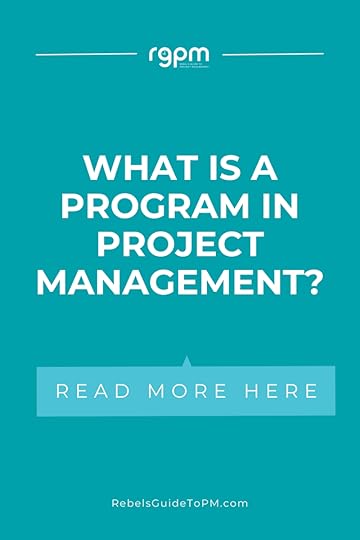
This article first appeared at Rebel's Guide to Project Management
September 25, 2022
Book review: Risk Happens
 Mike Clayton
Mike ClaytonMike Clayton defines risk as “uncertain events that can affect outcomes,” in his book, Risk Happens!: Managing Risk and Avoiding Failure in Business Projects. Risk management is the most important of your project controls. It enables you to manage the project more effectively and work towards a smooth outcome. So what exactly is project risk management? Clayton defines it as 3 things:
Processes to make the project more predictableTools to deal with the real world as it happensBehaviors and attitudes that allow us to cope when change does happen.Risk breakdown structuresClayton introduces the concept of the risk breakdown structure in his book. This basically uses the categories of time, cost, quality and scope from the enhanced triple constraint and breaks down the risk underneath these categories, much as you would do for a work breakdown structure.
The book includes a good explanation of product breakdown structures and work breakdown structures saying:
To move from a scope statement to a plan in your project definition, you will need to articulate your project activities and deliverables item-by-item. The tools that will allow you to do this are the WBS for setting out your activities, and the PBS for setting out your project deliverables, or products. Whichever you use is a matter partly of circumstance and partly of preference.
The WBS or PBS form a good basis for building a risk breakdown structure, as it is a way to ensure that you have covered the risks that relate to all areas of the project.
Using risk logs to manage riskA plan is nothing without action. Often, we unconsciously think that once we have planned for risk, the universe will get to hear about it and mysteriously prevent the risk from happening. It won’t. Your risk register is more than a record – it’s a management tool, so use it to manage.
 Mike’s book: Risk Happens!
Mike’s book: Risk Happens!Clayton makes a good point in the quote above: managing project risk is more than just a one-off brainstorming session and logging everything on a spreadsheet. You have to actively manage the risk, otherwise it won’t go away.
Of course, there are some risks that you don’t want to go away. Positive risk can positively impact your project, so you want your risk management plan to include actions that will make the risk a reality.
This book includes ways that you can capitalize on positive risk by enhancing the impact. And in case you can’t identify a positive risk unless it slaps you across the face, it also includes a short section on how to know one when you see one.
There is also some background information on how individuals and groups respond to risk. This is particularly useful when you are trying to put together a risk management plan, as you’ll get different responses to your management actions from different stakeholders and understanding how they think will help you realize that you aren’t going mad when they all respond in different ways.
Clayton also covers common things that affect our ability to make good judgements, such as the anchoring bias. This can lead us to set up risk management activities that are less than effective, or influence our approaches to managing project risk.
Set up your risk management structures straight awayThis book is a solid introduction to risk management and would be good for beginners. There is a good glossary and an appendix of common project risks – great if you want a starting point for brainstorming risk on your own project.
The book is not method specific, so it doesn’t matter if you use PRINCE2®, the PMI® equivalent or any other national or international standard.
There are useful tables and processes, which will save you having to work out a risk management process for yourself – handy if you are setting up a PMO and want to save some time. You could easily take what is in this book, tweak it a little to suit your project or company and implement a risk management approach straight away.
This article first appeared at Rebel's Guide to Project Management
What is a Program Manager?
First we should start with a definition of program management.
What is a program?A program is a collection of related individual projects, all with similar aims, objectives and resources that together deliver a common outcome and/or significant change; for example, moving the company to being a paperless office would be a program with a number of projects like:
Choosing and implementing an electronic document management system for Head OfficeDesigning a paperless sales process for use in the company’s shops and implementing it to all branchesLaunching an employee portal for electronic payslips and HR informationLaunching an electronic expense management system with approval workflowDeveloping the digital strategy for future projects to followAnd so on.
Each of these are projects with a project manager, but together they deliver a transformative change for the business. The overall change is managed as a program, under a program manager who consolidates program-level risks, manages resource conflicts across all projects, controls the budget and works with business owners to realize the benefits across all the initiatives.
Regardless of what type of program it is, programs tend to deliver strategic objectives and organizational change – bigger transformations than individual projects. Because of that, strategic alignment for the work is really important and you should be able to see how your work drives the organization forward.
What is Program Management?Program management is the ability to lead a program, keep all the moving parts moving in the right direction and deliver the overall change.
Program management requires a different skill set to project management, but it’s often considered as a future career move for experienced project managers.
Read next: Project Management versus Program ManagementWhat is a Program Manager?A program manager is someone who is responsible for leading a program of change. They coordinate the work of multiple teams managing multiple projects to ensure that overall, the business gets to where it wants to be.
You’ll find some program management skills do overlap with project management skills but the easiest way to think about it is this: a program manager sees things at the next level up from a project manager.
There are multiple projects with interdependent resources, risks, and timelines. There’s a lot more juggling to do. It’s a bigger picture role.
Personally, I always found program management more interesting because it’s more strategic, longer term and it’s easy to see the value.
However, you do have to be able to live with uncertainty and not be too stressed out not knowing the exact detail. There’s a lot of trust involved as the project managers need you to get out of the way so they can manage the detail.
Responsibilities for a Program ManagerLet’s look at what a program manager does all day. Much of this will be written into your job description.
In this role you’ll work under your own initiative most of the time. You’ll receive broad direction from your leadership team. You are responsible for maintaining the program plan and scheduling work at a relatively high level, and you’ll also assign tasks to other people. These could be project managers or PMO colleagues.
A program manager is responsible for:
Defining, facilitating and completing programs, including setting the approach. These will be made up of a number of projects with clear deadlines and direct business impactDesigning the program organization structure (get an org chart template) and securing the resources to do the workMaking sure project teams have what they need to get their work done and that there is a flow of communication up and down through the programHelping teams select the right project management methodologies for the type of work they are deliveringDay to day management of the program, including dealing with questions and escalations from project teamsIdentifying, assessing and managing risks that might stop the program being successfulEnsuring that the related project plans are realistic and up-to-date, in line with the methods used, and that they make it possible to meet deadlinesManaging dependencies between projectsPreparing, circulating and managing program documentationEnsuring that there is regular communication with the stakeholders, and that this accurately reflects what is going onRegular reporting to key stakeholders and the PMOEnsuring that quality reviews take place effectively and at the right timeManaging the change control procedure for the programBeing responsible for program governance including sitting on the Program Board and program controlsShowing strong leadershipPreparing a plan for benefits realization and ensuring that it is carried out so the organization receives the planned benefitEnsuring that project deliverables are completed within the parameters agreed around budget, resource and schedule, and that deliverables are handed over to users and signed offA successful program manager does all this.
What skills do you need to be a Program Manager?Program management isn’t the same as managing projects and the skills you need are quite different. However, they are certainly aligned and many project managers successfully make the leap into the more strategic and higher-level role of managing a program of work.
If you want to move into program management, these 5 skills will help you prove you are capable of doing the role:
Resource managementStakeholder engagementData analysis and synthesisData-driven decision makingChange management.You’ll see these skills on a program manager job description – and if you don’t you should be asking why!
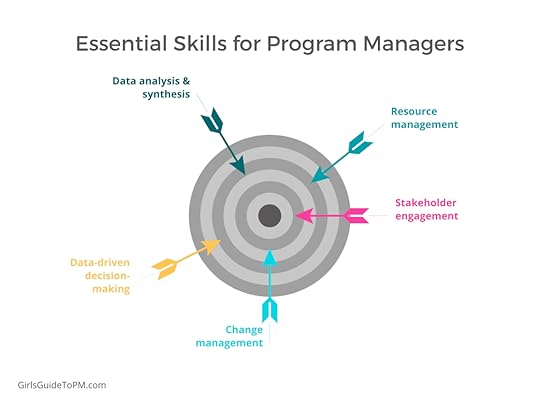
Practical experience as a project manager or operational (line) manager will also help.
1. Resource ManagementYou’ll need to be able to review work allocations across multiple teams and check people are working efficiently – and on the right tasks.
That might mean pulling people off a project to focus on another piece of work. You’ll need a good understanding of what the individual projects are all about so you can make sensible resource choices.
Resource management also involves capacity planning, so you’ll be looking ahead to what skills the program needs in the future and making sure the people on the teams can fill those needs. If they can’t, do a training needs analysis and get your team skilled up.
2. Stakeholder EngagementIn my experience, stakeholder engagement at program level is more ‘political’ with a small ‘p’. It’s part of the leadership skills you’ll have to demonstrate in the role.
There are more stakeholders to work with, and they tend to be higher up the organization. They have agendas of their own and are connected to strategy in ways you might not realize.
There have been a few times where I’ve been in the room with board members and they’ve said something that I had been totally unaware of – something that was a driving force behind shaping strategy within the company and the industry more broadly.
You’ve got to use business acumen and deal with the bigger picture on a much larger scale and the influences that puts on your stakeholder community.
3. Data Analysis and SynthesisData analysis is going to be significant for the future of project management. There are multiple data sources at program level and you have to look at them all, focusing in on what is really important.
It’s essential to be able to assimilate lots of information and condense it into a format that people can understand. You need to be able to tell the story of your program in a single slide, all the while focusing on what people want to know and need to know.
4. Data-Driven Decision MakingYou have to make decisions for the good of the program. That means relying on facts to work out what to do, not emotions.
You need the confidence to stand behind your decision and instruct people on what you’ve decided.
Basically, decision-making at this level requires more exposure because there are greater implications for when things go wrong. Honesty and transparency become more important in how you reached a decision.
5. Change ManagementIn the ‘old’ way of thinking, projects deliver outputs and programs deliver outcomes. I’ve always had a bit of an issue with that approach, but let’s not go there now.
Change management on programs is about making sure that the outputs from projects are integrated into the business and used. It’s important to make sure the end result is adopted (and, ideally, loved by users).
Being able to change behavior at an organizational level is key to being good at managing programs. People have to understand what the program is all about, how all the component projects contribute to the bigger picture and what role they help play in delivering this part of the strategy. (Because programs should in 99.9% of cases deliver strategy.)
What’s the career path for a program manager?After spending some time managing projects of some complexity, you’ll be thinking about the next phase of your career. Program management roles are often seen as a natural choice for project managers looking for their next challenge.
As businesses get more strategic with project management and start aligning projects together into programs of work, the need for skilled program managers grows. You might start asking yourself how to become a program manager because of the need from your company, in which case, you can simply go ahead and pitch that role to your management team.
(Make sure the proposal also includes the need to recruit a project manager to replace you.)
However, you could move into program management from a senior operational role or another PMO role as well.
Program Management in the OrganizationManaging a program should be considered a senior, influential, leadership role. It requires a wide range of interpersonal skills, experience and a fair bit of courage to be able to stand up, take the decisions, and lead organizational change at that level.
However, it’s a hugely rewarding job. When you see what’s being delivered through the individual projects and the benefits realization starts, you’ll appreciate what a mammoth effort you and other team members have made to make that happen.
Being able to juggle interconnected projects is truly a skill. It’s the way strategy gets delivered and it’s a role that supports colleagues across the organization because you put the plans in place to make their goals a reality.
FAQIs being a program manager hard?The technical skills are straightforward. The challenge with being a program manager comes in juggling the multiple stakeholder expectations and senior level politics within the organization.
Is being a program manager a good career?Yes, program managers are well-paid with good career prospects. It’s a respected and interesting job, so it is a good option for individuals wanting to move on from project management.
This is an edited extract from my book, Project Manager (BCS Books).
This article first appeared at Rebel's Guide to Project Management



